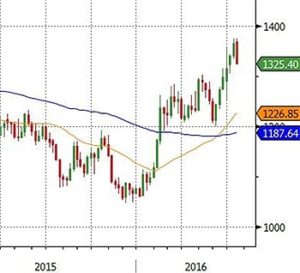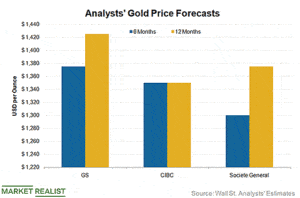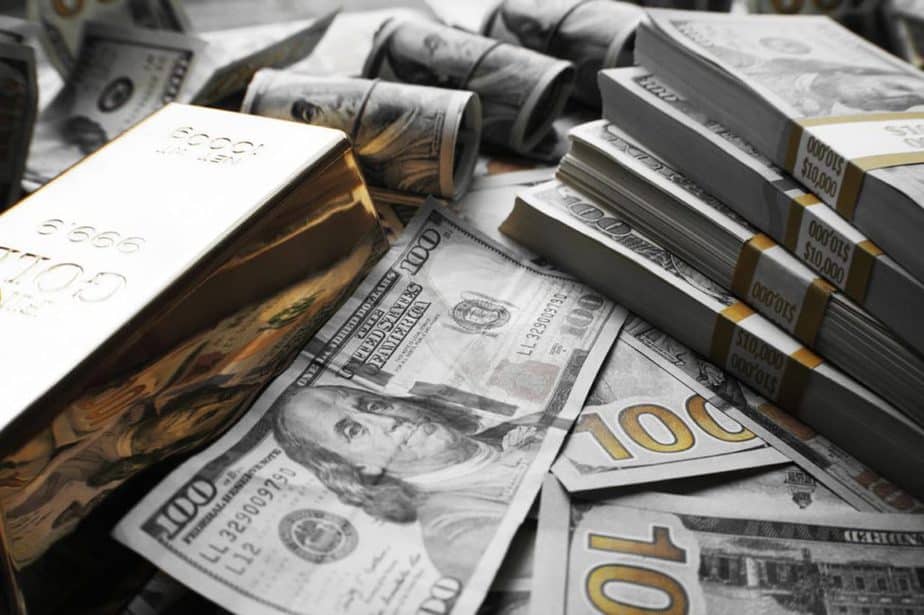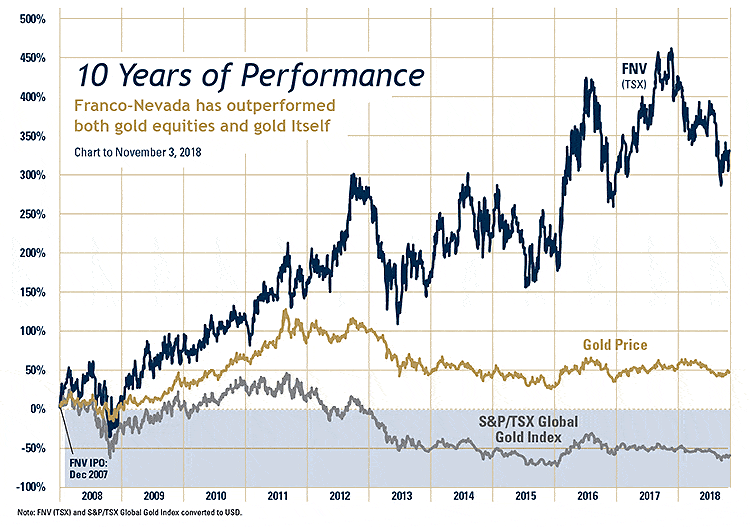
I’ve had a weather eye on gold for more than a year now. Gold could be the dark horse winner of 2019. I see the potential for mounting inflationary pressures after the US provided a massive tax cut while the economy was banging away on all cylinders, combined with the associated explosion of the US deficit, just for starters. The US is going to have to borrow a lot more money.
Upward pressure on rates is expected to continue through 2019. Some think that may be bad news for gold, but the market says otherwise. And, let’s face it, US leadership is damaging investor confidence and undermining global economic growth. In a word, it’s creating uncertainty—and markets hate uncertainty.
There are plenty of other reasons for increasing exposure to gold. We’ll get to those in just a moment.
But first, a quick nod to the gut. For the most part of the last year my gut on gold has been running against the overwhelming body of analysis—which has gold range-bound between $1,200 and $1,300.
At times like that, I’m inclined to recall contrarian mentality. Consensus in the markets can be very wrong, and if you’re on the other side of the equation, you can make exceptional profits when the unexpected comes to pass.
It takes a certain amount of resolve to take a position against what appears to be a powerful trend, but doing so can be very rewarding. I think that’s the case with gold today. Here’s why we have increased our exposure to gold and are beginning to see greater opportunity in gold equities.
First of all, gold has bottomed out at $1,200, and entered the early phase of a longer term bull market. Since scraping lows in the third quarter last year, gold has been steadily climbing back toward the $1,300 range. That trend seems likely to continue over the near term.
Next, there’s a seasonal upward bias to gold prices in the first quarter. Since 2013, gold has rallied by an average of eight percent from mid-December through mid-February with the GDX up an average of 24 percent. If financial risk continues to build, and the Fed becomes significantly more dovish than expected, we could see a more meaningful rally in gold similar to the one we saw in 2016.

In addition, the recent increase in equity market volatility could persist, given fears over slowing economic growth. A potential slowdown in the US economy could result in a weaker US dollar and increased investment in gold equities.[1]
Gold has indeed started 2019 on a positive tone, having recovered most of the losses suffered in the second half of 2018. Prices are up around 10 percent from the lows printed in August, touching an intraday high of $1,289 on the first business day of the new year and holding well.
The recent price move is encouraging, and shifts the focus to the $1,300 psychological level. Watch for gold to break above that and test the $1,350 intermediate resistance level in the first quarter.
More broadly, growing concerns about growth, lingering potential weakness in equities, a pause in the dollar’s strength, and lower real rates have already diverted a reasonable amount of attention to gold in recent months. That interest appears to be broad-based and investors are warming up towards gold as it reasserts its role as a safe haven.
The potential for weakening US data as higher trade tariffs really start to bind would be a positive catalyst, according to UBS. Although UBS analysts do not anticipate exceptionally strong physical demand for gold this year, they do expect volumes to be sufficient to underpin the market. Volumes on the Shanghai Gold Exchange main board are around average so far, albeit there has been a pick-up in turnover on the international board.[2]
Keith Trauner, co-portfolio manager of the GoodHaven mutual fund, which holds Barrick Gold (NYSE: ABX), reiterates that people have historically viewed gold as a hedge against government depreciation of local currency.
“Virtually every government in the world is trying to promote inflation partly because there is so much sovereign debt,” Trauner says. When there is so much debt, he contends, governments have three choices: default, restructure, or inflate the currency. “Politicians, when given the chance, will choose the latter,” he says.
Naysayers, he observes, point to higher interest rates as a negative for gold because it increases the allure of holding cash. But gold had one of its best decades during the inflationary 1970s, when rates soared.
According to Pierre Lassonde, the chairman and a co-founder of Franco-Nevada (NYSE: FNV), “Gold is the anti-dollar. When the dollar is strong, there is no need for gold. But when the dollar is weak, people go back to gold.”

Historically, gold and the dollar have a negative correlation of 80 percent to 85 percent. The dollar has been supported by expectations that the Federal Reserve will keep tightening and lift its benchmark federal-funds rate to 2.5–3.0 percent, from the current range of 1.75–2.0 percent by the end of 2019.[3] However, the impact on the dollar’s strength, given other factors, may be less than predictable.
Of particular note, most recently, Goldman Sachs raised their price forecast for gold, predicting that over 12 months the metal will climb to $1,425 an ounce—a level not seen in more than five years. Bullion has benefited as rising geopolitical tensions have fueled central bank purchases, while fears of a recession helped boost demand from investors seeking “defensive assets,” they say.[4]
Ray Dalio, founder of Bridgewater Associates, thinks the world today looks most analogous to the late 1930s. Like 80 years ago, financial markets are in the late stages of this short-term business cycle, given that the Federal Reserve is tightening monetary policy as US equity prices reach record highs, Dalio said during a recent live taping of a “Masters in Business” podcast.
He also sees rising “political polarity” in the form of populist candidates. On top of all that, the world is awash in debt, a longer-term problem without an easy solution given interest rates in many developed-market economies remain near record lows, and central banks have already purchased trillions of dollars worth of assets.
Dalio, who has a new book, “Principles for Navigating Big Debt Crises,” somehow maintains a calm demeanor given the sort of conclusions he’s drawn. Dalio effectively describes America’s worst nightmare: the dollar losing its place as the world’s reserve currency.
His concern—shared by BlackRock Inc.’s Larry Fink, among others—is that swelling US budget deficits will eventually irk big buyers overseas. Dalio said months ago that “You easily could have a 30 percent depreciation in the dollar” as the Fed has little choice but to monetize the national debt.
Dalio has said that investors should consider placing five to ten percent of their portfolio value in gold as a hedge against political risks.
One of Dalio’s main points, backed up by the rise in global debt, is that the entire world is “leveraged long.” Low interest rates have fueled buybacks, acquisitions, and ballooning stock prices.
That can’t last forever, he says. Broadly, “You need to prepare for lower expected returns in the future,” Dalio says. “You can expect lower returns and more taxes. That’s going to be the nature of the beast.” The only answer, he said, is to try to balance portfolios.
Gold now trades noticeably lower than normal related to the value of the S&P 500. An analysis of 72 years of Gold / S&P 500 ratio data (1945–2017) shows that with an S&P 500 at 2,500, gold should be priced at $2,800/oz., according to Ned W. Schmidt, CFA, in his Value View Gold Report.[5]
Perhaps most importantly, what looks pretty obvious now is that sentiment toward investing in gold has flipped. The bear market mentality driving the market up until the past year is now gone and the bulls are in the driver’s seat. Renewed speculative interest in gold signals investors are not only closing bearish bets but are also adding to bullish positions, according to Suki Cooper, an analyst at Standard Chartered.

Gold investors do have choices to make about how to play the coming run. My preference has always been to take advantage of the leverage available in gold equities, including select junior exploration and development ventures that can reward risk takers with high-gain returns.
Here are a few suggestions.
Agnico Eagle (NYSE: AEM/ TSX: AEM) is a senior Canadian gold mining company that operates eight mines in Canada, Finland, and Mexico. It also has exploration and development activities in each of these countries as well as in the United States and Sweden.
After topping CAN$62 in early July, the share price went into a slump, reflecting what was happening with the price of gold. Gold production was 404,961 oz. at an all-in sustaining cost (AISC) of $921 per oz.
More importantly, the company raised its production guidance for the year. Two major new projects in Nunavut (Amaruq and Meliadine) are coming on stream in 2019, which should increase production substantially.
Agnico remains the best-managed gold major with increases in production in politically safe jurisdictions. It should see overall output reaching 1.65 million oz. by 2020. It has a low debt to equity ratio, at 28 percent.
Franco-Nevada (NYSE: FNV/ TSX: FNV) is a gold royalties and streaming company with a large and diversified portfolio of cash-flow producing assets in Canada, the US, Australia, Africa, and Latin America. Its portfolio is widely diversified geographically and by mineral, with the intention of deriving 80 percent from precious metals and 20 percent from oil and gas and other minerals.

This has been the best performing gold stock over the last five years. The shares hit an all-time high of $110.18 last November before retreating to the current level as the price of gold declined.
Franco-Nevada bought the rights to all of the gold and silver stream from the massive Cobre Panama copper and gold mine for $356 million in March and contributed $70 million to the construction cost. It expects to contribute another $160–180 million to construction for the rest of 2018 to complete its $1 billion contribution. Cobre Panama is expected to start production in 2019.
Franco-Nevada also bought an oil and gas royalty portfolio for $101.8 million in the Permian Basin in Texas in February and has just committed $220 million to buy the royalties for the SCOOP and STACK fields in Oklahoma, with a commitment to spend $100 million a year for the next three years.
The quarterly dividend was increased summer 2018 by a penny to US$0.24 a quarter (US$0.96 per year). That equates to a yield of 1.3 percent. It was the 11th consecutive year the company has increased its payout.
Goldcorp (NYSE: GG/ TSX: G) Its portfolio includes mines in Canada, the US, and Latin America. It is the second largest global gold miner, with annual production for 2018 estimated at 2.5 million oz. at an AISC of $800/oz.
In the second quarter of 2018, Goldcorp produced 571,000 oz. at an AISC of $850/oz. That compared to 635,000 oz. at an AISC of $800/oz. in the same period last year. This partially reflected the ramp-up of production at the Eleonore and Cerro Negro mines in Quebec and Mexico.
Goldcorp recorded a loss of $131 million ($0.15 per share, figures in US dollars). This was primarily due to $178 ($0.20 per share) million of non-cash foreign exchange losses. Operating cash flows and adjusted operating cash flows for the three months to June 30 were $158 million and $310 million respectively compared to $158 million and $320 million in 2017.
CEO David Garofalo has set a target of reducing AISC costs by 20 percent while increasing output and reserves also by 20 percent by 2021. Such projects as the Penasquito Leach program in Mexico and the Musselwhite materials handling project in Canada are on time and on budget to achieve these ends, while the company's exploration programs are proving successful.
Goldcorp remains a Buy. It is one of the largest gold stocks by market capitalization and should benefit from any buying by investors.
Speculative junior exploration and development ventures offer investors the opportunity to get high price appreciation rewards. Typically these low priced stocks can turn in dramatic price runs when they succeed on exploration programs, or team up with a major gold producer. High risk and high reward—that’s the attraction.
Canada is the capital for most of these stocks, and you’ll find them trading on the TSX Venture Exchange, and in some cases co-listed on the OTC Markets.
Ascot Resources (TSX-V: AOT/ OTCQX: AOTVF) is a Vancouver-based junior exploration company publicly traded on the TSX Venture Exchange and OTCQX upper tier microcap market in the US Ascot is focused on re-starting the past producing historic Premier gold mine, once North America’s largest gold mine, located in British Columbia’s Golden Triangle.
The Company’s near-term strategic goal is to define a new high-grade resource for underground mining, while continuing to explore nearby targets on its Premier-Dilworth properties, situated just 25 kilometers north of the town of Stewart. The Company also has two other projects; Swamp Point, an aggregate project located in British Columbia on the Portland Canal and Mt. Margaret, a porphyry copper-molybdenum-gold-silver deposit located in Washington State, USA.
Aurion Resources Ltd.’s (TSX-V: AU) strategy is to generate or acquire early stage precious metals exploration opportunities and advance them through business partnerships or joint venture arrangements. Aurion’s current focus in on developing its projects in Finland where the Company currently has a joint venture arrangement with B2 Cold Corp.
The prospect generator business model employed by Aurion’s experienced management team has proven to create shareholder value through business partnerships with some of the industry’s leading mining companies while protecting the capital structure and treasury of the company.
Juggernaut Exploration Ltd. (TSX-V: JUGR) engages in acquiring, exploring and evaluating mineral resource properties. It focuses on Midas Property in the northeast of Terrace, British Columbia and Empire Property located in the southeast of Terrace, British Columbia.
Skeena Resources Limited (TSXV: SKE) is a junior Canadian mining exploration company focused on developing prospective precious and base metal properties in the Golden Triangle of northwest British Columbia, Canada. The company’s primary activities are the exploration and development of the past-producing Snip mine and the recently optioned Eskay Creek mine, both acquired from Barrick. In addition, the company has completed a Preliminary Economic Assessment on the GJ copper-gold porphyry project.
As always, it’s critical that you do your own due diligence before making any investment decisions. Consult your investment advisor, and position yourself within a portfolio context that best suits your own risk/ reward profile.

Blake Desaulniers, Contributor
for Investors News Service
P.S. To discover more opportunities in the hottest sectors in North America, sign up now to the Financial News Now newsletter to get the latest updates and investment ideas directly in your inbox!
DISCLAIMER: Investing in any securities is highly speculative. Please be sure to always do your own due diligence before making any investment decisions. Read our full disclaimer here.
[1] RBC Q1/19 Global Mining Best Ideas
[2] UBS Global Precious Metals Comment
[3] Barron’s: Gold Is Cheap. Inflation Is Coming. You Do the Math
[4] https://www.bloomberg.com/news/articles/2019-01-10/goldman-predicts-bullion-prices-to-climb-to-highest-since-2013?utm_content=business&utm_source=twitter&utm_campaign=socialflow-organic&cmpid=socialflow-twitter-business&utm_medium=social&fbclid=IwAR1ZpdjV8fJLq6RfdI_x-fE6VGt7THMM8HhHwnZ8JfjcjzvEJ2Lzi9h19Bg
[5] The Value View Gold Report, November 2018